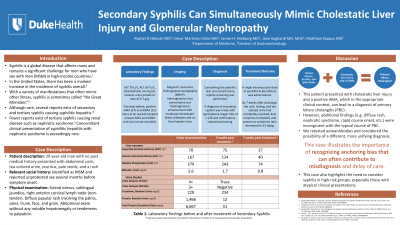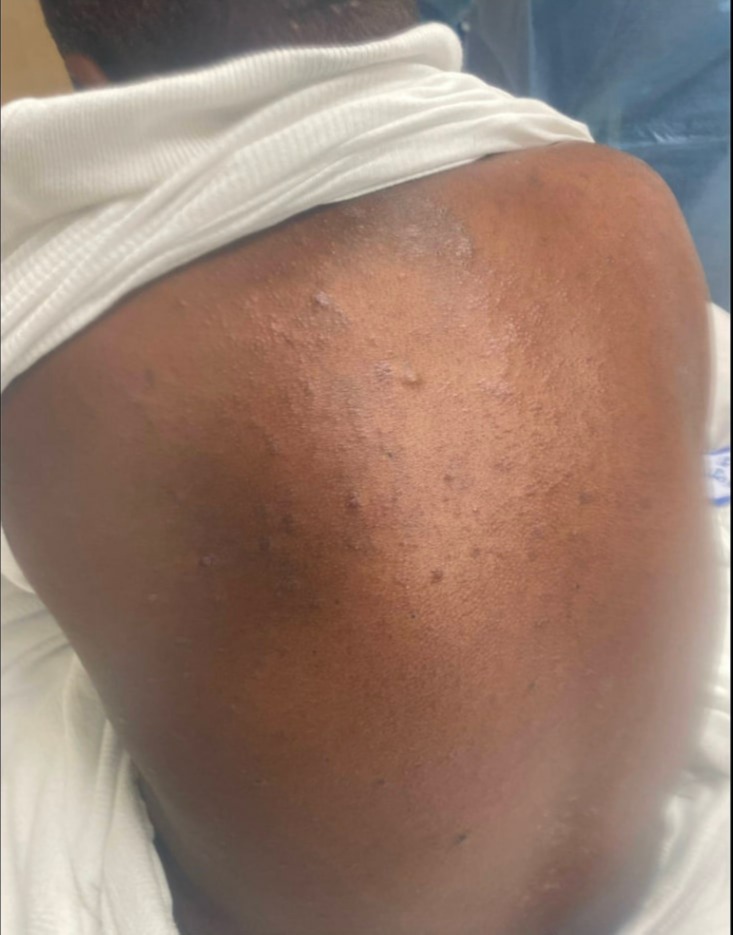Tuesday Poster Session
Category: Liver
P3984 - Secondary Syphilis Can Simultaneously Mimic Primary Biliary Cholangitis and Glomerular Nephropathy
Tuesday, October 24, 2023
10:30 AM - 4:00 PM PT
Location: Exhibit Hall

Has Audio

Rachel Obimah, MD
Duke University School of Medicine
Durham, NC
Presenting Author(s)
Rachel Obimah, MD, Omar Martinez-Uribe, MD, James H. Helzberg, MD, Jane Gagliardi, MD, MHS, Matthew Kappus, MD
Duke University School of Medicine, Durham, NC
Introduction: Syphilis is a global disease that remains a significant challenge for men who have sex with men (MSM). Known as “the Great Mimicker,” it manifests diversely and can mimic many illnesses. There are few reports of syphilis causing syphilitic hepatitis or nephrotic syndrome, though simultaneous occurrence is exceedingly rare. We describe a case of syphilis presented as concurrent glomerular nephropathy and cholestatic hepatitis, initially thought to be cholestatic liver disease.
Case Description/Methods: The patient, a 29-year-old MSM with no past medical history, presented with abdominal pain, tea-colored urine, pruritus, and a rash. His social history was notable for unprotected sex months before symptom onset. Physical examination showed a papular rash on the palms, soles, trunk, face, and groin, as well as scleral icterus. Laboratory tests showed an alkaline phosphatase of 279 U/L, aspartate aminotransferase (AST) of 70 U/L, alanine aminotransferase (ALT) of 167 U/L, total bilirubin of 5.6 mg/dL, and random urine protein-to-creatinine ratio of 6,667mg/g. Five days prior to presentation, anti-mitochondrial antibody (AMA) and anti-smooth muscle antibody (ASMA) tests returned positive (AMA 57, ASMA 31). Magnetic resonance cholangiopancreatography revealed moderate intrahepatic biliary dilatation and heterogenous perfusion of the liver. Considering his rash and social history, syphilis screening was performed. A diagnosis of secondary syphilis was made with rapid plasma reagin titer of 1:128 and confirmatory treponemal testing. A single intramuscular dose of penicillin G benzathine was administered. By 7 weeks after discharge, the rash, itching, and tea colored urine had completely resolved, liver enzymes had normalized, and protein-to-creatinine ratio had decreased to 51 mg/g. Notably, repeat AMA and ASMA were negative prior to treatment.
Discussion: Our patient presented with signs of cholestatic liver injury, biliary dilatation, and a positive AMA, which are features consistent with a diagnosis of primary biliary cholangitis (PBC). Because his additional findings did not fit PBC, we retested his autoantibodies and considered the possibility of a different, more unifying diagnosis. This case highlights the need to consider syphilis in high-risk groups, even with cholestatic liver injuries and nephrotic syndrome. Avoiding anchoring bias and maintaining a broad differential is crucial to arrive at the appropriate diagnosis.

Disclosures:
Rachel Obimah, MD, Omar Martinez-Uribe, MD, James H. Helzberg, MD, Jane Gagliardi, MD, MHS, Matthew Kappus, MD. P3984 - Secondary Syphilis Can Simultaneously Mimic Primary Biliary Cholangitis and Glomerular Nephropathy, ACG 2023 Annual Scientific Meeting Abstracts. Vancouver, BC, Canada: American College of Gastroenterology.
Duke University School of Medicine, Durham, NC
Introduction: Syphilis is a global disease that remains a significant challenge for men who have sex with men (MSM). Known as “the Great Mimicker,” it manifests diversely and can mimic many illnesses. There are few reports of syphilis causing syphilitic hepatitis or nephrotic syndrome, though simultaneous occurrence is exceedingly rare. We describe a case of syphilis presented as concurrent glomerular nephropathy and cholestatic hepatitis, initially thought to be cholestatic liver disease.
Case Description/Methods: The patient, a 29-year-old MSM with no past medical history, presented with abdominal pain, tea-colored urine, pruritus, and a rash. His social history was notable for unprotected sex months before symptom onset. Physical examination showed a papular rash on the palms, soles, trunk, face, and groin, as well as scleral icterus. Laboratory tests showed an alkaline phosphatase of 279 U/L, aspartate aminotransferase (AST) of 70 U/L, alanine aminotransferase (ALT) of 167 U/L, total bilirubin of 5.6 mg/dL, and random urine protein-to-creatinine ratio of 6,667mg/g. Five days prior to presentation, anti-mitochondrial antibody (AMA) and anti-smooth muscle antibody (ASMA) tests returned positive (AMA 57, ASMA 31). Magnetic resonance cholangiopancreatography revealed moderate intrahepatic biliary dilatation and heterogenous perfusion of the liver. Considering his rash and social history, syphilis screening was performed. A diagnosis of secondary syphilis was made with rapid plasma reagin titer of 1:128 and confirmatory treponemal testing. A single intramuscular dose of penicillin G benzathine was administered. By 7 weeks after discharge, the rash, itching, and tea colored urine had completely resolved, liver enzymes had normalized, and protein-to-creatinine ratio had decreased to 51 mg/g. Notably, repeat AMA and ASMA were negative prior to treatment.
Discussion: Our patient presented with signs of cholestatic liver injury, biliary dilatation, and a positive AMA, which are features consistent with a diagnosis of primary biliary cholangitis (PBC). Because his additional findings did not fit PBC, we retested his autoantibodies and considered the possibility of a different, more unifying diagnosis. This case highlights the need to consider syphilis in high-risk groups, even with cholestatic liver injuries and nephrotic syndrome. Avoiding anchoring bias and maintaining a broad differential is crucial to arrive at the appropriate diagnosis.

Figure: 29 -year-old man presented with diffuse rash located on his trunk (pictured), face, palms, soles, and groin.
Disclosures:
Rachel Obimah indicated no relevant financial relationships.
Omar Martinez-Uribe indicated no relevant financial relationships.
James Helzberg indicated no relevant financial relationships.
Jane Gagliardi indicated no relevant financial relationships.
Matthew Kappus indicated no relevant financial relationships.
Rachel Obimah, MD, Omar Martinez-Uribe, MD, James H. Helzberg, MD, Jane Gagliardi, MD, MHS, Matthew Kappus, MD. P3984 - Secondary Syphilis Can Simultaneously Mimic Primary Biliary Cholangitis and Glomerular Nephropathy, ACG 2023 Annual Scientific Meeting Abstracts. Vancouver, BC, Canada: American College of Gastroenterology.

